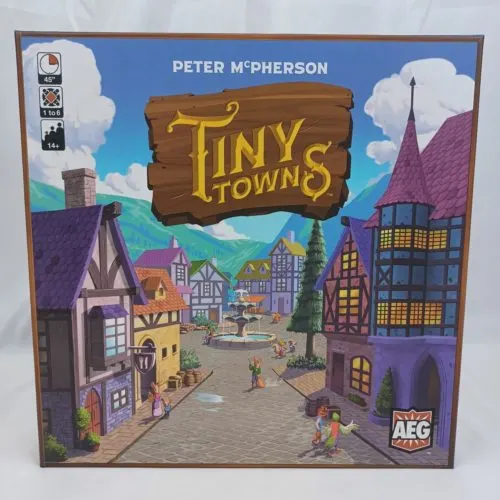
Tiny Towns was originally released in 2019 by Alderac Entertainment Group and designed by Peter McPherson. In the game each player plays as the mayor of a tiny town in the forest. The creatures of the forest have banded together to form a town. As their mayor you are tasked with utilizing your town’s resources in the best way to create a thriving town to help all of your citizens. Can you create a more successful town than your competition to win Tiny Towns?
Year: 2019 | Publisher: Alderac Entertainment Group | Designer: Peter McPherson | Artist: Gong Studios
Genres: Abstract, City Building
Ages: 14+ | Number of Players: 1-6 | Length of Game: 45-60 minutes
Difficulty: Light-Moderate | Strategy: Moderate | Luck: Light-Moderate
Components: 6 player boards, 25 Building cards, 15 Monument cards, 15 Resource cards, 126 wooden buildings, 1 Master Builder hammer, 6 wooden monuments, 90 wooden Resource cubes, scorepad, instructions
Where to Purchase: Amazon, eBay
Any purchases made through these links (including other products) help keep Geeky Hobbies running. Thank you for your support.
Objective of Tiny Towns
In Tiny Towns the objective of the game is to score more points than the other players. You will place Resource cubes into your town. When you create certain patterns you can construct Buildings which will score you points.
Setup for Tiny Towns
- Each player takes a player board.
- The Resource cards are returned to the box unless you are playing the Town Hall or Solo variants.
- Place the Cottage card face up in the center of the table.
- The rest of the Building cards are sorted by their types/symbols on the back of the cards. Shuffle each group separately and randomly select one card from each group to place face up on the table. The rest of the Building cards are returned to the box.
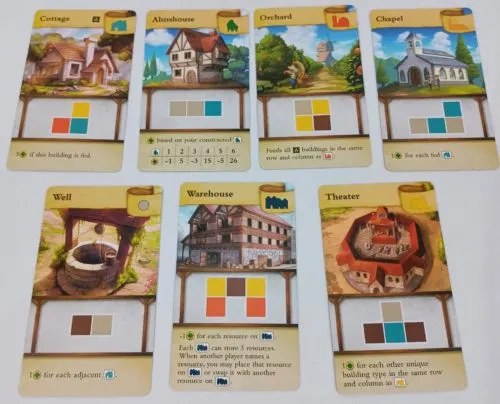
- Place the wooden buildings and resources into piles in the middle of the table where everyone can reach them. Do not place the Monuments (purple buildings) in the center of the table.
- Shuffle the Monument cards and deal two to each player. Each player will look at the two cards and choose one to keep. Players will keep this Monument card secret from the other players and will discard the other card.
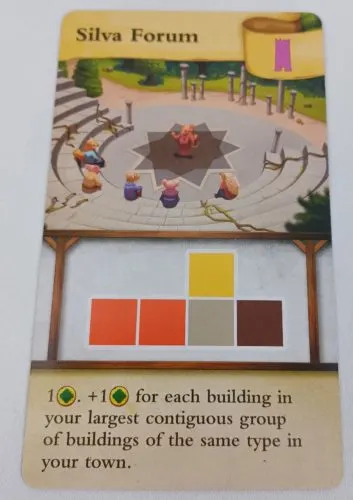
- Each player will take one wooden Monument. The rest of the wooden Monuments will be returned to the box.
- The last player to build something in real life will be the first player to start the game. They will take the white hammer to indicate that they are the Master Builder for the first turn.
Playing Tiny Towns
Tiny Towns is played over a number of rounds. Each round follows the same set of steps.
Each round begins with the Master Builder choosing a type of resource (color cube). All of the players must take a cube of the chosen color and place it onto a space in their town grid. All players can do this at the same time. If you ever run out of a color of cubes, find another marker to represent the color cube that is missing. For rules regarding how cubes can be placed, see the Placing Cubes section below.
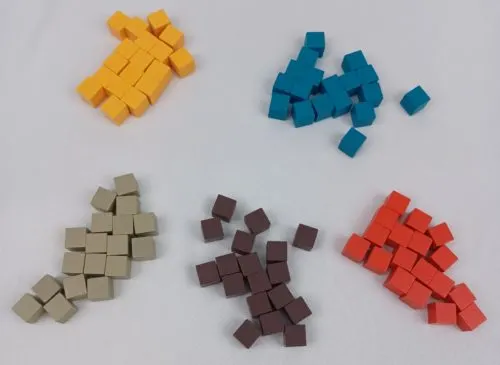
After placing the cube they acquired this round, a player can choose to construct one or more buildings. For details on how to construct buildings, see the Constructing Buildings Section below.
Once everyone has finished placing their cube and constructing buildings (if they want), the round ends. The role of Master Builder (white hammer) is passed to the next player to the left.
Placing Cubes
A player must follow the corresponding rules when placing a cube.
- Once a cube has been placed, it cannot be moved to another space.
- Cubes can only be removed from your board when you construct a building.
- Only one resource or a building can be placed on each square on a player’s board.
- When a resource is removed through a building being constructed, the cube is returned to the general supply.
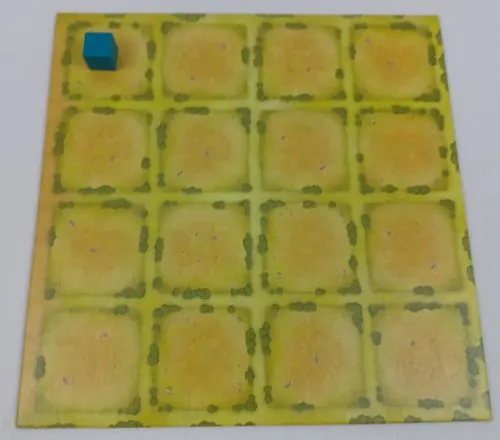
Tiny Towns has a variant rule called the Cavern Rule that players can agree to use at the beginning of the game. If you choose to use this rule, up to two of the resources chosen by other players during the game can be set aside and not placed onto your board. These cubes score no points or penalties at the end of the game.
Constructing Buildings
The objective of Tiny Towns is to place cubes onto your board that match the patterns shown on the face up Building cards on the table. Once you have placed the right colored cubes into a pattern shown on one of the Building cards, you can choose to construct the corresponding Building.
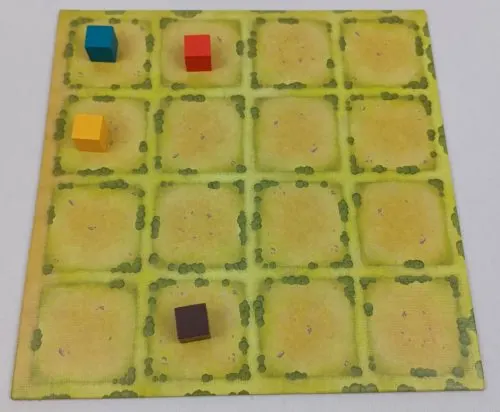
When constructing a Building you will follow the corresponding steps.
- You will remove the corresponding cubes from your board and return them to the general supply.
- Take the corresponding wooden Building from the general supply.
- Choose one of the spaces that were occupied by one of the cubes that you used to construct the Building. You will place the wooden Building on the space you chose.
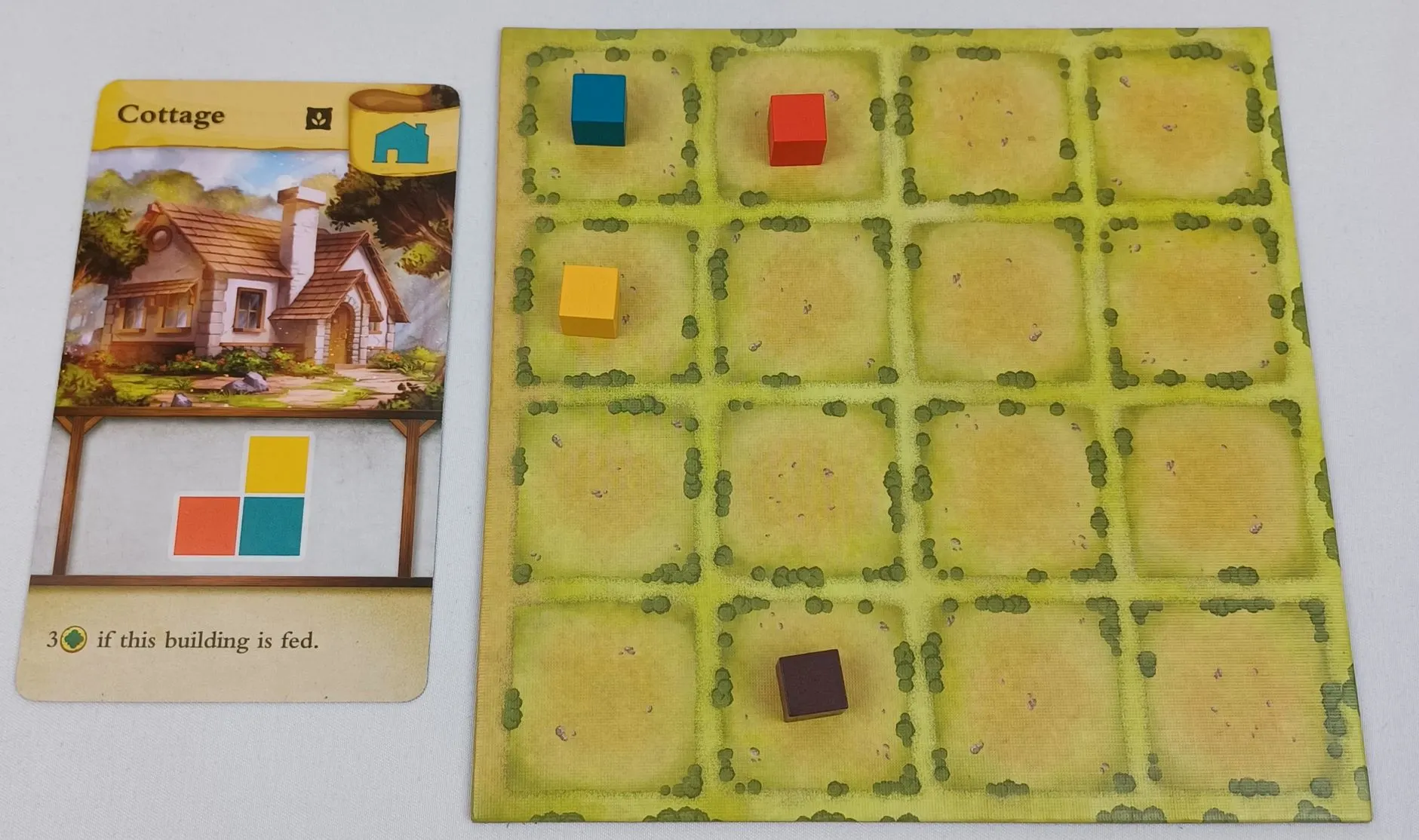
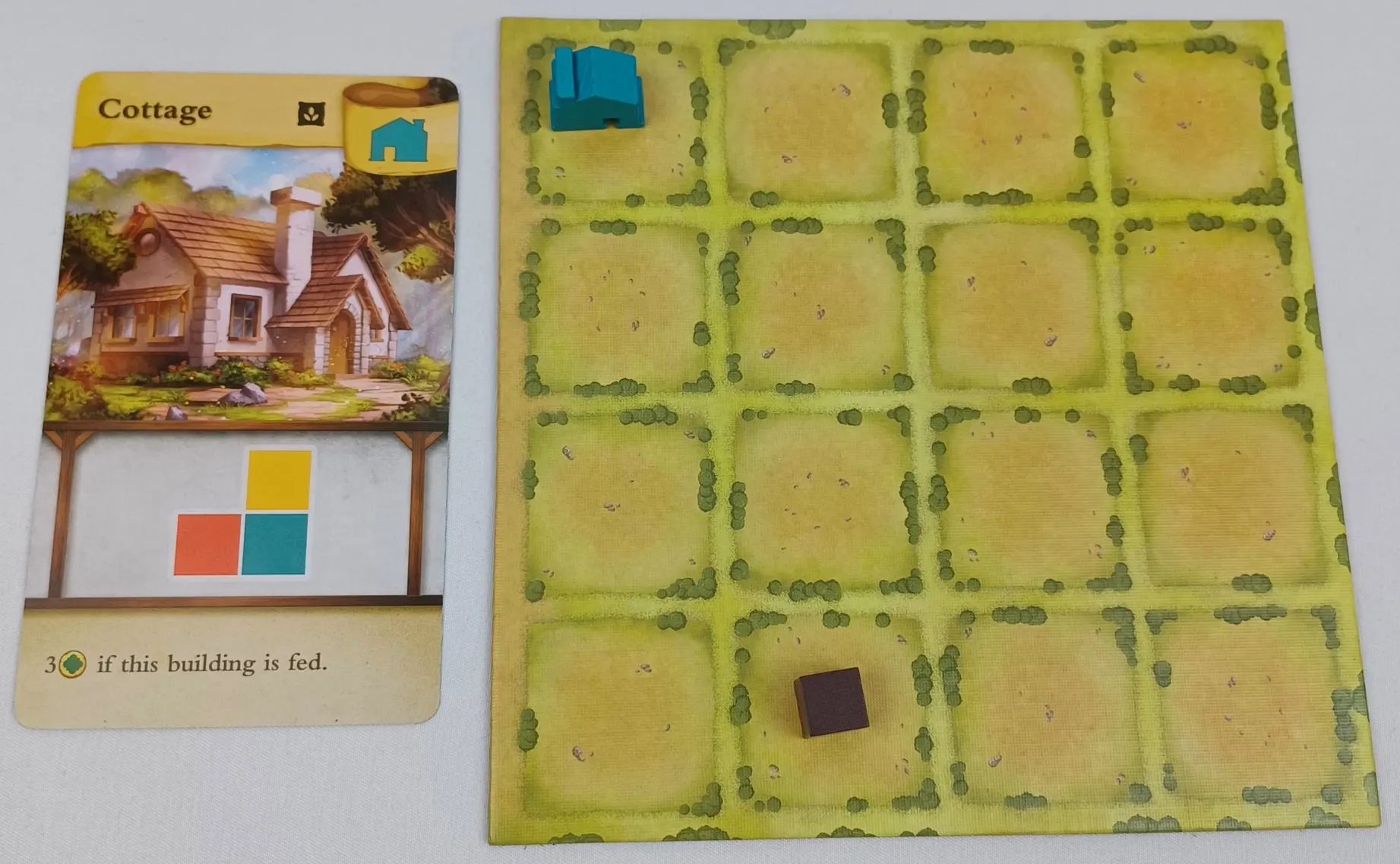
A few additional rules that must be followed when constructing a Building:
- Each cube can only be used to construct one Building.
- You don’t need to construct a Building as soon as the pattern is present on your board. The Building can be constructed on a future turn.
- You may construct multiple Buildings in one turn.
- A Building may never be moved once it is constructed.
- You can build as many of each Building type as you want (except for your Monument). Only one Monument may be placed on your board each game.
- You must place a cube on your board before you can use it to construct a Building.
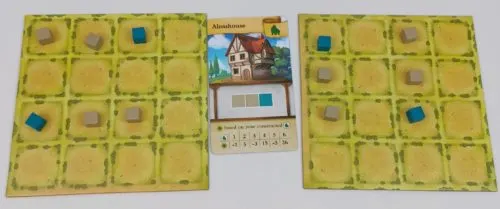
Building A Monument
During setup each player received a Monument card. This is a special building that only the player that holds the card can build. The Monument is built in the same way as any other building. Players can only build it once.
When the Monument is constructed the player will reveal the card and read out the special ability that it provides the player. The card’s ability goes into effect immediately and only applies to the player that owns the card.
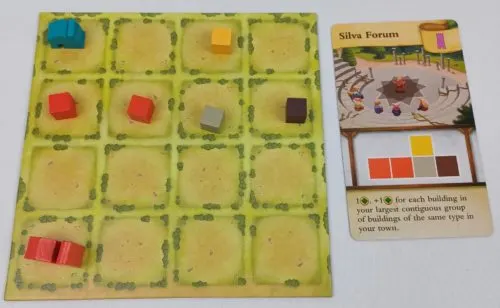
Completing Your Town
When your town is filled with resources and you can no longer/don’t want to construct any more Buildings, your town is completed. You will take no more turns for the rest of the game. You will no longer take any more cubes and you won’t take your turn choosing a new cube color as a Master Builder. While waiting for the other players to finish up, you can start to count up the points you scored in the game.
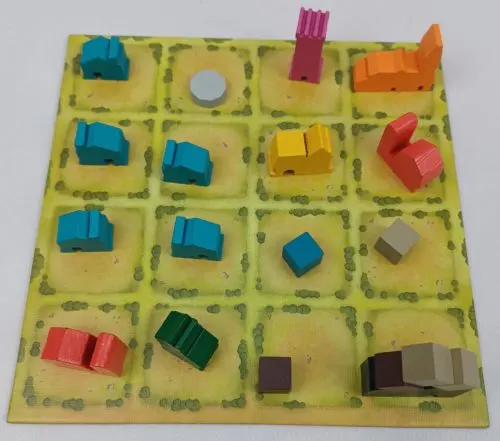
When only one player remains in the game, they will keep choosing new cubes for themselves until their town is completed.
End of Game in Tiny Towns
Tiny Towns ends once all of the players have completed their town.
Players will then tally up their points earned during the game.
All cubes placed on the board outside of those placed on a Warehouse will be removed from your board. Each empty space left on your board is worth -1 point.
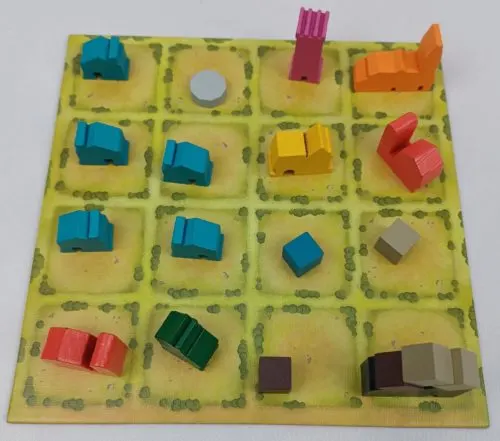
Players will then tally the points that they earned for each of the Buildings in their town. To see how each type of Building scores see the Buildings section below.
The player that scored the most points wins Tiny Towns. If there is a tie, the tied player who was Master Builder the least times wins the game. If there is still a tie, the tied player with the least empty squares in their town wins. The next tiebreaker goes to the player with the most Cottages. If the tie is still not broken, the tied players will share the victory.
Buildings in Tiny Towns
Here are details for what each building does in Tiny Towns.
Cottages (Blue Buildings)
Cottages must be fed in order to score points. They are fed by red buildings. Each fed cottage scores three points. An unfed cottage scores zero points. Cottages can be built before they are fed.
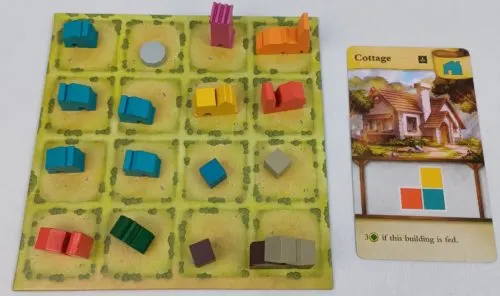
Red Buildings
Farm – Feeds four cottages anywhere in your town.
Granary – Feeds all eight cottages in the spaces that surround the granary.
Greenhouse – Feeds one continuous group of adjacent (up, down, left, right) cottages anywhere in your town. The group does not have to be connected to the greenhouse.
Orchard – Feeds all of the cottages in the same row and column as the orchard.
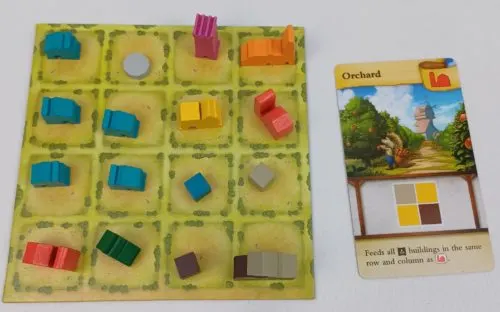
Gray Buildings
Fountain – Scores two points if it is adjacent to another fountain. Can score a maximum of two points.
Millstone – Scores two points if adjacent to a red or yellow building. Can score a maximum of two points.
Shed – When constructed the shed can be placed on any empty space in your town. It does not have to be placed on one of the two spaces that were occupied by the resources that were used. Each shed is worth one point.
Well – Scores one point for each adjacent cottage. The well will score points even if the cottage is not fed.
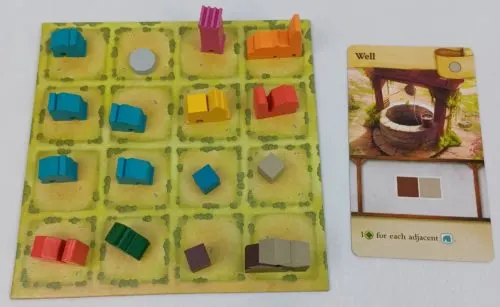
Orange Buildings
Abbey – The abbey will score three points if it is not adjacent to a black, green or yellow building. If one of these types of buildings are adjacent to the abbey, it will score zero points.
Chapel – Each chapel is worth one point for each fed cottage. Each chapel will score points for every fed cottage.
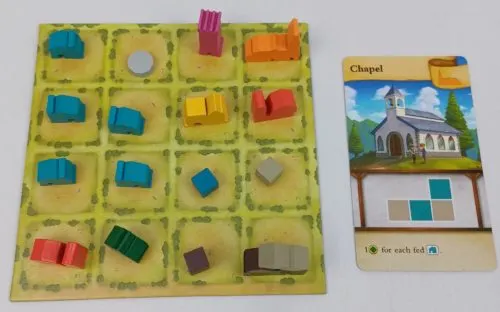
Cloister – Each cloister not placed in a corner will score one point for each cloister placed in a corner. Each cloister can score a maximum of four points.
Temple – Each temple that is adjacent to at least two fed cottages will score four points. If there aren’t two or more adjacent cottages, the temple scores zero points.
Green Buildings
Almshouse – Almshouses score points based on how many of them you have constructed in your town. The amount of points you score is based on the chart at the bottom of the card. If you have more than six Almsmhouses, you will still only score 26 points.
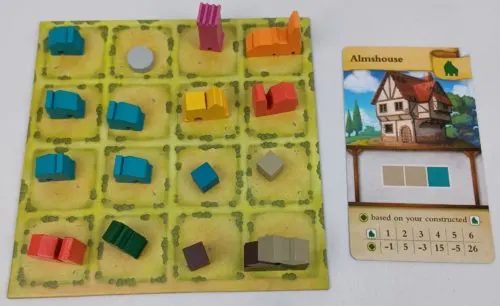
Feast Hall – Each feast hall is worth two points on its own. If you have more feast halls than the player on your right, each feast hall is worth three points. If you have the same number of feast halls as the player on your right, you will only score two points for each feast hall.
Inn – Each inn that has no other inns in the same row or column will score three points. If two inns share the same row or column, both will score zero points.
Tavern – Taverns score points based on the number that you have constructed. The amount of points you score is based on the chart at the bottom of the card. If you construct more than five taverns you will still only score 20 points.
Yellow Buildings
Bakery – A bakery will score three points if it is adjacent (not diagonal) to a red or black building.
Market – A market will score one point for each yellow building in the same row or column. The market itself will score one point for itself.
Tailor – Tailors will score one point and one additional point for each yellow building in the four center squares of your town. The maximum number of points a tailor can score is five.
Theater – The theater will score one point for each different color building in the same row and column as the theater. If the same color is in both the row and column, that color will only score one point total. Monuments count as a unique building type except for Barret Castle. The maximum number of points a theater can score is six.
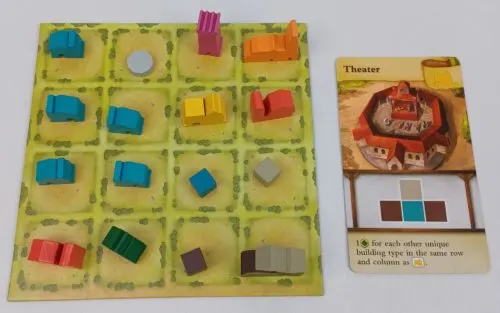
Black Buildings
Bank – Each bank is worth four points. When you construct a bank you will place a colored cube on it that is not on another bank in your town. When you are the Master Builder, you can no longer choose the color that you have placed on a bank. You can have a maximum of five banks in your town.
Factory – When you construct a factory you will place one of the five cube colors on it. When another player chooses that color, you may choose a different color cube for yourself.
Trading Post – You can use the trading post as a resource/cube of any other color when constructing a nearby building. You may use multiple trading posts to construct a building, but you must also use at least one cube. The trading post will stay in place. The trading post is worth one point.
Warehouse – Each warehouse can store three different resources. If a player chooses a color cube you don’t want to place in your town, you can choose to place it on your warehouse. You may also choose to swap the chosen color cube for one currently in one of your warehouses. The only way to remove a cube from your warehouse is when you replace it with a new cube. The warehouse is worth -1 points for each cube it stores at the end of the game.
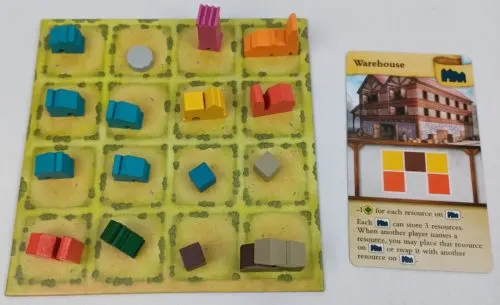
Monuments
Architect’s Guild – When constructed you can choose to replace up to two of the buildings in your town with different types of buildings. You may choose not to use this ability, but you cannot choose to then use it later. You cannot change a building into another Monument. The Architect’s Guild is worth one point.
Archive of the Second Age – Worth one point for each unique building type (other than a Monument) in your town.
Barrett Castle – Worth five points if feed. The Monument counts as two cottages/blue buildings for scoring at the end of the game.
Cathedral of Caterina – Any empty spaces in your town are worth zero points instead of -1. The Monument is also worth two points itself.
Fort Ironweed – The Monument is worth seven points. Unless you are the last player remaining in the game, you no longer take turns as the Master Builder.
Grand Mausoleum of the Rodina – Any unfed cottages/blue buildings are worth three points each.
Grove University – You will immediately place a building on an empty square in your town. You can choose any building type except for another Monument. The Grove University is also worth three points.
Mandras Palace – Each adjacent building (left, right, up, down) that is a different color scores two points for the Mandras Palace.
Opaleye’s Watch – When you construct the Monument, immediately choose three unique buildings on the card. Whenever a player to your left or right constructs a building of a type still on the card, you will take the building from the card and place it on any empty square in your town. You may not choose to place a Monument on the card to be placed later.
Obelisk of the Crescent – Whenever you build any future buildings, you may place them on any empty squares in your town.
Shrine of the Elder Tree – This Monument will score points based on the number of buildings in your town when you construct it. The amount of points you score is based on the chart printed on the card. If you build the Monument as your seventh or later building, you still only score eight points.
Silva Forum – The Monument is worth one point by itself. It will also score one point for each building of one color in the largest contiguous group in your town.
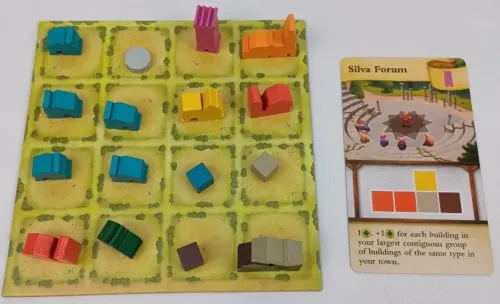
The Sky Baths – The Monument scores two points for each building type that is not present in your town.
The Starloom – The Monument scores points based on when you complete your town in comparison to the other players. The amount of points you score is based on the chart printed on the card. If you finish on the same turn as other players, you will score points for the highest place you could have placed.
Statue of the Bondmaker – Whenever another player chooses a resource, you may choose to place it on a square that has a cottage/blue building. Each of these spaces can contain one cube. Resources placed on these spaces cannot be used later to construct buildings.
Town Hall Variant
The players can choose to use the Tiny Towns Town Hall variant if they want to change how resources are chosen throughout the game. This variant uses the Resource deck of cards.
One player will be chosen as the Mayor who will draw Resource cards throughout the game.
Shuffle the 15 Resource cards to form a draw pile. The top five cards from the deck are discarded.
In the first round the Mayor will turn over the top card from the Resource deck. The resource pictured will be the resource that all players must place into their town. For the second round another card is drawn which will determine which resource each of the players will have to use.
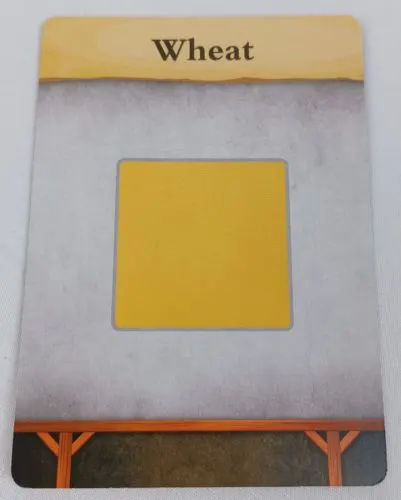
For the third round each player will get to choose for themselves which resource they would like to place in their town.
All subsequent rounds follow this same pattern. When the Resource deck runs out of cards, the discard pile will be shuffled to form a new draw pile. The top five cards will be discarded.
With this variant a few of the Building rules are altered.
- Any card that refers to when other players choose resources, applies to rounds when the drawn card determines what resource is chosen.
- The bank’s ability only applies to rounds in which the player gets to choose a resource.
- If a player builds Fort Ironweed, they will skip all rounds where they get to choose a resource.
Solo Tiny Towns Variant
In the Tiny Towns solo game you cannot use the inn, bank, Fort Ironweed, or Opaleye’s Watch.
In the solo game you will shuffle the Resource cards and reveal the top three cards. You will choose a resource from one of the three face up Resource cards each round. When you choose to use a Resource card, you will discard it and replace it with a new card.
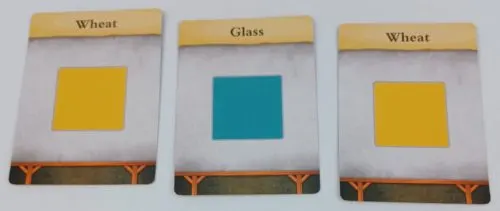
Any Buildings that refer to another player choosing resources, will instead apply to choosing resources from the Resource deck.
The game ends once you have completed your town. You will check how well you did based on the following chart:
- 38+ points – Master Architect
- 32-37 – Town Planner
- 25-31 – Engineer
- 18-24 – Carpenter
- 10-17 – Builder’s Apprentice
- 9 or less – Aspiring Architect

Shed
Wednesday 15th of March 2023
Looks like fun Ill have to order this for my son
Tiny Towns Board Game Review - Geeky Hobbies
Wednesday 4th of May 2022
[…] you would like to see the complete rules/instructions for how to play Tiny Towns, check out our how to play […]